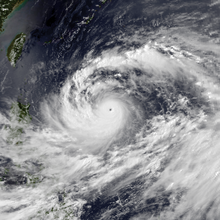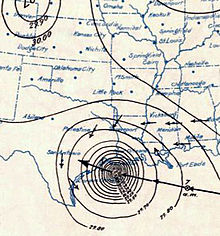Portal:Tropical cyclones
The Tropical Cyclones Portal

A tropical cyclone is a storm system characterized by a large low-pressure center, a closed low-level circulation and a spiral arrangement of numerous thunderstorms that produce strong winds and heavy rainfall. Tropical cyclones feed on the heat released when moist air rises, resulting in condensation of water vapor contained in the moist air. They are fueled by a different heat mechanism than other cyclonic windstorms such as Nor'easters, European windstorms and polar lows, leading to their classification as "warm core" storm systems. Most tropical cyclones originate in the doldrums, approximately ten degrees from the Equator.
The term "tropical" refers to both the geographic origin of these systems, which form almost exclusively in tropical regions of the globe, as well as to their formation in maritime tropical air masses. The term "cyclone" refers to such storms' cyclonic nature, with anticlockwise rotation in the Northern Hemisphere and clockwise rotation in the Southern Hemisphere. Depending on its location and intensity, a tropical cyclone may be referred to by names such as "hurricane", "typhoon", "tropical storm", "cyclonic storm", "tropical depression" or simply "cyclone".
Types of cyclone: 1. A "Typhoon" is a tropical cyclone located in the North-west Pacific Ocean which has the most cyclonic activity and storms occur year-round. 2. A "Hurricane" is also a tropical cyclone located at the North Atlantic Ocean or North-east Pacific Ocean which have an average storm activity and storms typically form between May 15 and November 30. 3. A "Cyclone" is a tropical cyclone that occurs in the South Pacific and Indian Oceans.
Selected named cyclone -
Typhoon Thelma, known in the Philippines as Typhoon Katring, was the first super typhoon to form in the 1987 Pacific typhoon season. Forming from the monsoon trough in the Philippine Sea, Thelma was first designated as a tropical cyclone on July 7. After moving north, Thelma turned west, while remaining poorly organized. It finally attained typhoon status on July 9, soon after developing an eye, and began to intensify at a brisker clip. During the evening of July 10, Thelma attained maximum intensity while well to the east of the northern Philippines. It also turned sharply northward in response to a trough, slowly weakening. On July 15, Typhoon Thelma, now greatly reduced in intensity, struck the south coast of South Korea. The next day, Thelma rapidly dissipated, shortly after emerging into the Sea of Japan.
Although Thelma remained well offshore the Philippines, around 500 homes were swept away due to flooding, which left more than 3,500 people homeless. A total of 130 people were rescued after a vessel sunk. Nationwide, 12 people perished. In Japan, the typhoon brought heavy rains that was responsible for property damage in 19 prefectures. Throughout the country, three people died while around 1,000 dwellings were flooded. (Full article...)Selected article -
The 1900 Galveston hurricane, also known as the Great Galveston hurricane and the Galveston Flood, and known regionally as the Great Storm of 1900 or the 1900 Storm, is the deadliest natural disaster in United States history. The strongest storm of the 1900 Atlantic hurricane season, it left between 6,000 and 12,000 fatalities in the United States; the number most cited in official reports is 8,000. Most of these deaths occurred in and near Galveston, Texas, after the storm surge inundated the coastline and the island city with 8 to 12 ft (2.4 to 3.7 m) of water. As of 2024, it remains the fourth deadliest Atlantic hurricane on record, behind Hurricane Fifi of 1974. In addition to the number killed, the storm destroyed about 7,000 buildings of all uses in Galveston, which included 3,636 demolished homes; every dwelling in the city suffered some degree of damage. The hurricane left approximately 10,000 people in the city homeless, out of a total population of fewer than 38,000. The disaster ended the Golden Era of Galveston, as the hurricane alarmed potential investors, who turned to Houston instead. In response to the storm, three engineers designed and oversaw plans to raise the Gulf of Mexico shoreline of Galveston Island by 17 ft (5.2 m) and erect a 10 mi (16 km) seawall.
On August 27, 1900, a ship east of the Windward Islands detected a tropical cyclone, the first observed that year. The system proceeded to move steadily west-northwestward and entered the northeastern Caribbean on August 30. It made landfall in the Dominican Republic as a weak tropical storm on September 2. It weakened slightly while crossing Hispaniola, before re-emerging into the Caribbean Sea later that day. On September 3, the cyclone struck modern-day Santiago de Cuba Province and then slowly drifted along the southern coast of Cuba. Upon reaching the Gulf of Mexico on September 6, the storm strengthened into a hurricane. Significant intensification followed and the system peaked as a Category 4 hurricane with maximum sustained winds of 145 mph (235 km/h) on September 8. Early on the next day, it made landfall to the south of Houston. The cyclone weakened quickly after moving inland and fell to tropical storm intensity late on September 9. The storm turned east-northeastward and became extratropical over Iowa on September 11. The extratropical system strengthened while accelerating across the Midwestern United States, New England, and Eastern Canada before reaching the Gulf of Saint Lawrence on September 13. After striking Newfoundland later that day, the extratropical storm entered the far North Atlantic Ocean and weakened, with the remnants last observed near Iceland on September 15. (Full article...)Selected image -

Selected season -

The 2019 North Indian Ocean cyclone season was the second most active North Indian Ocean cyclone season on record in terms of cyclonic storms, the 1992 season was more active according to the Joint Typhoon Warning Center. The season featured 12 depressions, 11 deep depressions, 8 cyclonic storms, 6 severe cyclonic storms, 6 very severe cyclonic storms, 3 extremely severe cyclonic storms, and 1 super cyclonic storm, Kyarr, the first since Cyclone Gonu in 2007. Additionally, it also became the third-costliest season recorded in the North Indian Ocean, only behind the 2020 and 2008 seasons.
The season's first named storm, Pabuk, entered the basin on January 4, becoming the earliest-forming cyclonic storm of the North Indian Ocean on record. The second cyclone of the season, Cyclone Fani, at the time was the strongest tropical cyclone in the Bay of Bengal by 3-minute maximum sustained wind speed until it got tied with Cyclone Mocha of 2023, and minimum barometric pressure since the 1999 Odisha cyclone, while being equal in terms of maximum 3-minute sustained wind speed to 2007's Sidr and 2013's Phailin. Further activity occurred in October, and in the latter part of that month, the first and only super cyclonic storm of the 2010s, Kyarr, formed. (Full article...)Related portals
Currently active tropical cyclones

Italicized basins are unofficial.
- North Atlantic (2024)
- No active systems
- East and Central Pacific (2024)
- No active systems
- West Pacific (2024)
- No active systems
- North Indian Ocean (2024)
- No active systems
- Mediterranean (2023–24)
- No active systems
- South-West Indian Ocean (2023–24)
- No active systems
- Australian region (2023–24)
- No active systems
- South Pacific (2023–24)
- No active systems
- South Atlantic (2023–24)
- No active systems
Last updated: 21:50, 2 June 2024 (UTC)
Tropical cyclone anniversaries

June 9
- 1934 - A hurricane struck what is now Belize after looping across Central America. The storm killed at least 516 people along its path.
- 1989 - Typhoon Dot (track pictured) reached peak strength as a Category 3 while nearing landfall over in Hainan, causing 8 deaths and CN¥170 million (US$45.1 million) of damages.
- 1998 - A cyclone struck the Indian state of Gujarat, killing at least 4,000 people.

June 10
- 1974 - Typhoon Dinah made landfall on the island of Luzon in the Philippines. Dinah killed 73 people in the Philippines, Hainan and Vietnam.
- 1991 - Cyclone Gritelle (pictured) became a named system, making it the strongest system within the south-west Indian Ocean to form in the month of June, as well as the latest in the cyclone year to be properly named.

June 11
- 1996 - A tropical cyclone (pictured) struck Oman and produced widespread flooding across the Arabian Peninsula, killing 341 people and leaving US$1.2 billion in damage.
Did you know…




- …that the Joint Typhoon Warning Center considers that Typhoon Vera (pictured) of 1986 is actually two distinct systems, formed from two separated low-level circulations?
- …that Hurricane Agatha (pictured) was the strongest Pacific hurricane to make landfall in Mexico in May since records began in 1949?
- …that Cyclone Raquel (track pictured) travelled between the Australian and South Pacific basins between the 2014–15 and 2015–16 seasons, spanning both seasons in both basins?
- …that Cyclone Amphan (pictured) in 2020 was the first storm to be classified as a Super Cyclonic Storm in the Bay of Bengal since 1999?
General images -

The list of Florida hurricanes from 1900 to 1949 encompasses 108 Atlantic tropical cyclones that affected the U.S. state of Florida. Collectively, tropical cyclones in Florida during the time period resulted in about $4 billion (2008 USD) in damage. Additionally, tropical cyclones in Florida were directly responsible for about 3,550 fatalities during the time period, most of which from the 1928 Okeechobee Hurricane. The 1947 season was the year with the most tropical cyclones affecting the state, with a total of 6 systems. The 1905, 1908, 1913, 1927, 1931, 1942, and 1943 seasons were the only years during the time period in which a storm did not affect the Floridan coasts.
The strongest hurricane to hit the state during the time period was the 1935 Labor Day hurricane, which also bears the distinction of being the strongest recorded hurricane to strike the United States. Several other major hurricanes struck the state during the time period, including the 1926 Miami hurricane, the 1928 Okeechobee hurricane, and a cyclone each in 1945, 1947, 1948, and 1949. All of these storms made landfall as Category 4 hurricanes. (Full article...)Topics
Subcategories
Related WikiProjects
WikiProject Tropical cyclones is the central point of coordination for Wikipedia's coverage of tropical cyclones. Feel free to help!
WikiProject Weather is the main center point of coordination for Wikipedia's coverage of meteorology in general, and the parent project of WikiProject Tropical cyclones. Three other branches of WikiProject Weather in particular share significant overlaps with WikiProject Tropical cyclones:
- The Non-tropical storms task force coordinates most of Wikipedia's coverage on extratropical cyclones, which tropical cyclones often transition into near the end of their lifespan.
- The Floods task force takes on the scope of flooding events all over the world, with rainfall from tropical cyclones a significant factor in many of them.
- WikiProject Severe weather documents the effects of extreme weather such as tornadoes, which landfalling tropical cyclones can produce.
Things you can do
 |
Here are some tasks awaiting attention:
|
Wikimedia
The following Wikimedia Foundation sister projects provide more on this subject:
-
Commons
Free media repository -
Wikibooks
Free textbooks and manuals -
Wikidata
Free knowledge base -
Wikinews
Free-content news -
Wikiquote
Collection of quotations -
Wikisource
Free-content library -
Wikiversity
Free learning tools -
Wikivoyage
Free travel guide -
Wiktionary
Dictionary and thesaurus
























































